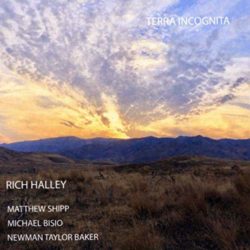Jazz CD Review: Two Quartets Discover Exhilarating New Terrain
By Steve Feeney
The powerful quartets on The People I Love and Terra Incognita work toward locating places beyond notation where, in each moment, new vistas may emerge.
The People I Love, Steve Lehman Trio + Craig Taborn (Pi Recordings)
Terra Incognita, Rich Halley Quartet (Pine Eagle Records)
 Two August releases confirm that, amid all the grand statements attempted in jazz today, there is still a lot of good music to be found within the relatively unassuming sax-piano-bass-drums quartet format. Of course, it must be noted that the pair of quartet discs considered here are made up of either a working trio plus guest or a lead player plus guest trio.
Two August releases confirm that, amid all the grand statements attempted in jazz today, there is still a lot of good music to be found within the relatively unassuming sax-piano-bass-drums quartet format. Of course, it must be noted that the pair of quartet discs considered here are made up of either a working trio plus guest or a lead player plus guest trio.
The assertive foursome on Steve Lehman’s new The People I Love comprises the leader (also sax) and his longstanding trio-mates Matt Brewer (bass) and Damion Reid (drums). The addition of Craig Taborn (piano) gives the group both a grace and a charge that challenges them all.
Perhaps in part due to his work with Vijay Iyer, Lehman’s originals are mostly based in a modal approach that allows some hard-charging soloing to develop above an irresistible harmonic web fashioned by Taborn and the others. Lehman’s work can be a little chilly at times, but here things grow warmer.
“Ih Calam & Ynnus” begins with a chiming figure from the pianist that invites Lehman in for a round of intense blowing in a hyperkinetic onslaught of brief phrases elaborated into controlled variations. Taborn then peels off a similarly emphatic series of right-hand runs that might surprise those more accustomed to his ethereal side.
“Curse Fraction” takes the tempo down just a touch, with Lehman more halting between brief bursts of energy. Like the cadences of an aggressive poet, a creative jolt accompanies each line.
“Beyond All Limits” starts off with Brewer’s opening solo, but then quickly exchanges pithiness for rhapsody. The leader’s scalar entry finds a home in Taborn’s pensive exploration of chords that establish a field in which fluttery figures gradually assert a conversation that reaches toward a sort of delirium among the instrumental voices.
“Chance,” a composition by Kenny Kirkland, provides a welcome bit of lyricism to a release that succeeds in exploring the exciting possibilities within quartet music — a direction that sounds refreshingly new.
While 41-year-old Lehman’s music on his latest disc takes a welcome turn away from his more formal efforts, his approach remains just short of pointillism next to the performances of the 71-year-old tenor saxophonist Rich Halley. The veteran Halley’s sound applies broader brushstrokes on canvases that are inspired by a still compelling free jazz tradition.
 Terra Incognita is Halley’s first release in several years to include a pianist. He’s chosen an impeccable one in the person of Matthew Shipp, an established purveyor of uncompromising music. The pianist’s regular trio-mates, Michael Bisio (bass) and Newman Taylor Baker (drums), fill out the group.
Terra Incognita is Halley’s first release in several years to include a pianist. He’s chosen an impeccable one in the person of Matthew Shipp, an established purveyor of uncompromising music. The pianist’s regular trio-mates, Michael Bisio (bass) and Newman Taylor Baker (drums), fill out the group.
One of Halley’s early enthusiasms was for the blues and this informs his work within an open, emotive approach that recalls Shipp’s former employer, the late David S. Ware. The form also traces further back to the tenor giants John Coltrane, Pharoah Sanders, and Albert Ayler in its determination to push the limits of the tenor sax toward shouts and screams of improvisational (and spiritual) abandon.
“Opener” sets up the fortuitous tensions within the group. Bisio and Baker supply a low rumble that grows into a more expansive environment, with Shipp’s pensive meanderings engaging with Halley’s gestural language. Baker’s solo leads to a walking bass line over which Halley mulls a moment before exploring the outer limits of the tenor’s range.
“The Journey,” the longest cut on the disc at 17 minutes-plus, starts like a slowly evolving adventure in the broad landscapes that adorn the album’s cover. Once momentum is established, Halley is off into the abstract wilderness, with Shipp offering close support. The pianist then solos in a bit more of a reflective mode, assembling and disassembling notes into clusters that brace plaintive cries from the returning Halley.
In the title piece, the leader establishes a matrix in which each player maps a complementary discourse. Halley suggests melodic avenues and then Shipp kicks off a section of interplay that launches Halley off on a spate of upper-register exhortations that establish that we’re in wild territory indeed. Bisio and Baker end the piece in a slowly quieting retreat.
Steve Feeney is a Maine native and attended schools in Maine, New Hampshire, and Massachusetts. He has a Master of Arts Degree in American and New England Studies from the University of Southern Maine. He began reviewing music on a freelance basis for the Portland Press Herald/Maine Sunday Telegram in 1995. He was later asked to also review theater and dance. Recently, he has added BroadwayWorld.com as an outlet and is pleased to now contribute to The Arts Fuse.
Tagged: Craig Taborn, PI Recordings, Pine Eagle Records, Rich Halley Quartet, Steve Feeney, Steve Lehman Trio, Terra Incognita
